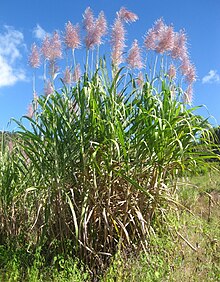Saccharum officinarum
| Saccharum officinarum | |
|---|---|
 |
|
| Saccharum officinarum growing in Mozambique | |
| Scientific classification | |
| Kingdom: | Plantae |
| (unranked): | Angiosperms |
| (unranked): | Monocots |
| (unranked): | Commelinids |
| Order: | Poales |
| Family: | Poaceae |
| Subfamily: | Panicoideae |
| Tribe: | Andropogoneae |
| Genus: | Saccharum |
| Species: | S. officinarum |
| Binomial name | |
|
Saccharum officinarum L. |
|
Saccharum officinarum, sugarcane, is a large, strong-growing species of grass in the genus Saccharum. It originated in southeast Asia and is now cultivated in tropical and subtropical countries worldwide for the production of sugar and other products.
S. officinarum, a perennial plant, grows in clumps consisting of a number of strong unbranched stems. A network of rhizomes forms under the soil which sends up secondary shoots near the parent plant. The stems vary in colour, being green, pinkish, or purple and can reach 5 m (16 ft) in height. They are jointed, nodes being present at the bases of the alternate leaves. The internodes contain a fibrous white pith immersed in sugary sap. The elongated, linear, green leaves have thick midribs and saw-toothed edges and grow to a length of about 30 to 60 cm (12 to 24 in) and width of 5 cm (2.0 in). The terminal inflorescence is a panicle up to 60 cm (24 in) long, a pinkish plume that is broadest at the base and tapering towards the top. The spikelets are borne on side branches and are about 3 mm (0.12 in) long and are concealed in tufts of long, silky hair. The fruits are dry and each one contains a single seed. Sugarcane harvest typically occurs before the plants flower, as the flowering process causes a reduction in sugar content.
Portions of the stem of this and several other species of sugarcane have been used from ancient times for chewing to extract the sweet juice. It was cultivated in New Guinea about 8000 years ago for this purpose. Extraction of the juice and boiling to concentrate it was probably first done in India more than 2000 years ago.
S. officinarum and its hybrids are grown for the production of sugar, ethanol, and other industrial uses in tropical and subtropical regions around the world. The stems and the byproducts of the sugar industry are used for feeding to . Pigs fed on sugarcane juice and a soy-based protein supplement produced stronger piglets that grew faster than those on a more conventional diet. As its specific name (officinarum, "of dispensaries") implies, it is also used in traditional medicine both internally and externally.
...
Wikipedia
